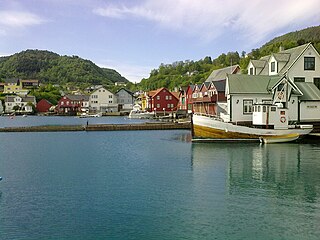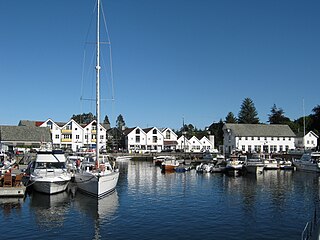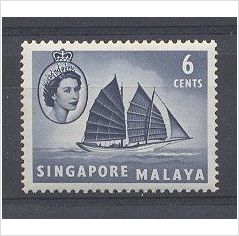
Viking ships were marine vessels of unique structure, used in Scandinavia from the Viking Age throughout the Middle Ages. The boat-types were quite varied, depending on what the ship was intended for, but they were generally characterized as being slender and flexible boats, with symmetrical ends with true keel. They were clinker built, which is the overlapping of planks riveted together. Some might have had a dragon's head or other circular object protruding from the bow and stern for design, although this is only inferred from historical sources. Viking ships were used both for military purposes and for long-distance trade, exploration and colonization.

Tysnes is a municipality in Vestland county, Norway. It is located in the traditional district of Sunnhordland. The administrative centre is the village of Uggdal. Other population centres in Tysnes include the villages of Våge and Onarheim. The island municipality is located in a group of islands near the mouth of the Hardangerfjorden. The majority of the municipal population lives on the island of Tysnesøya, the largest island in the municipality.

Os is a former municipality in the old Hordaland county, Norway. It was located in the Midhordland region, just south of Norway's second-largest city, Bergen. Due to its proximity to Bergen, Os experienced strong population growth. The administrative centre of Os was the village of Osøyro. It is the largest settlement in the municipality, with over 60% of the municipal residents living here. Other large villages in Os included Hagavik, Halhjem, Søfteland, Søre Øyane, and Søvik.

Austevoll is a municipality and an archipelago in Vestland county, Norway. It is located in the traditional district of Midthordland in Western Norway. The administrative centre is the village of Storebø on the island of Huftarøy. Other villages include Årland, Austevollshella, Bakkasund, Bekkjarvik, Birkeland, Haukanes, Husavik, Kolbeinsvik, Otterå, Våge, and Vinnes.
Boat racing is a sport in which boats, or other types of watercraft, race on water. Boat racing powered by oars is recorded as having occurred in ancient Egypt, and it is likely that people have engaged in races involving boats and other water-borne craft for as long as such watercraft have existed.

Located on an isolated sandy peninsula known as "Sandy Point," at the entrance to Chichester Harbour, England, the Hayling Island Sailing Club, was founded in 1921. The first clubhouse was originally a fisherman's cottage adjacent to Salterns Quay, and known as Quay Cottage. After a short while, the club moved into the premises now occupied by the Mengham Rythe Sailing Club.

The Cornish pilot gig is a six-oared rowing boat, clinker-built of Cornish narrow-leaf elm, 32 feet (9.8 m) long with a beam of 4 feet 10 inches (1.47 m). It is recognised as one of the first shore-based lifeboats that went to vessels in distress, with recorded rescues going back as far as the late 17th century. The original purpose of the Cornish pilot gig was as a general work boat, and the craft is used as a pilot boat, taking pilots out to incoming vessels off the Atlantic Coast. At the time pilots would compete between each other for work; the fastest gig crew who got their pilot on board a vessel first would get the job, and hence the payment.
The term skiff is used for a number of essentially unrelated styles of small boats. Traditionally, these are coastal craft or river craft used for leisure, as a utility craft and for fishing, and have a one-person or small crew. Sailing skiffs have developed into high performance competitive classes. Many of today's skiff classes are based in Australia and New Zealand in the form of 12 ft (3.66 m), 13 ft (3.96 m), 16 ft (4.88 m) and 18 ft (5.49 m) skiffs. The 29er, 49er, SKUD and Musto Skiff are all considered to have developed from the skiff concept, all of which are sailed internationally.

The spritsail is a four-sided, fore-and-aft sail that is supported at its highest points by the mast and a diagonally running spar known as the sprit. The foot of the sail can be stretched by a boom or held loose-footed just by its sheets. A spritsail has four corners: the throat, peak, clew, and tack. The Spritsail can also be used to describe a rig that uses a spritsail.

Scalloway is the largest settlement on the west coast of Mainland, the largest island of the Shetland Islands, Scotland. The village had a population of roughly 900, at the 2011 census. Now a fishing port, until 1708 it was the capital of the Shetland Islands.

Coastal and offshore rowing is a type of rowing performed at sea. Due to the harsher conditions encountered, the boats are wider and more robust than those used on rivers and lakes. In North America, this sport is often called open water rowing.

Raven's Ait is an ait (island) in the Thames between Surbiton, Kingston and Hampton Court Park in the Royal Borough of Kingston upon Thames, London, England, in the reach of the river above Teddington Lock. Used as a boating training centre for many years, Raven's Ait is currently privately run as a catering facility and a conference and wedding venue.

Skiffing refers to the sporting and leisure activity of rowing a Thames skiff. The skiff is a traditional hand built clinker-built wooden craft of a design which has been seen on the River Thames and other waterways in England and other countries since the 19th century. Sculling is the act of propelling the boat with a pair of oars, as opposed to rowing which requires both hands on a single oar.
The yoal, often referred to as the ness yoal, is a clinker-built craft used traditionally in Shetland, Scotland. It is designed primarily for rowing, but which also handles well under its traditional square sail when running before the wind or on a broad reach.
The East Coast Rowing Council is the regional organisation of Skiff rowing on Ireland's East coast, representing the sport of Coastal and ocean rowing. As per local tradition, coastal rowing is undertaken by crews of four with one sweep oar each, and a coxswain, in wooden clinker-built boats. Formed in 1936, the ECRC has the task of formalising the rules, organising regatta dates and judging any disputes between members. Rules were laid down as to sizes and weights of skiffs to make races fairer. The ECRC represents clubs in the counties of Dublin, Wicklow, and North Wexford.

A double scull is a rowing boat used in the sport of competitive rowing. It is designed for two persons who propel the boat by sculling with two oars each, one in each hand.

Traditionally, many different kinds of boats have been used as fishing boats to catch fish in the sea, or on a lake or river. Even today, many traditional fishing boats are still in use. According to the United Nations Food and Agriculture Organization (FAO), at the end of 2004, the world fishing fleet consisted of about 4 million vessels, of which 2.7 million were undecked (open) boats. While nearly all decked vessels were mechanised, only one-third of the undecked fishing boats were powered, usually with outboard engines. The remaining 1.8 million boats were traditional craft of various types, operated by sail and oars.

The pinas, sometimes called "pinis" as well, is one of two types of junk rigged schooners of the east coast of the Malay peninsula, built in the Terengganu area. This kind of vessel was built of Chengal wood by the Malays since the 19th century and roamed the South China Sea and adjacent oceans as one of the two types of traditional sailing vessels the late Malay maritime culture has developed: The bedar and the pinas.

The St. Ayles Skiff is a 4 oared rowing boat, designed by Iain Oughtred and inspired by the traditional Fair Isle skiff. The boat’s hull and frames are built using clinker plywood and it measures 22’ with a beam of 5’ 8”. It is normally crewed by four sweep rowers with a coxswain.

Anna Karoline is a jekt often called Nordlandsjekt, built at Brataker in Mosvik, Norway in 1876.


















